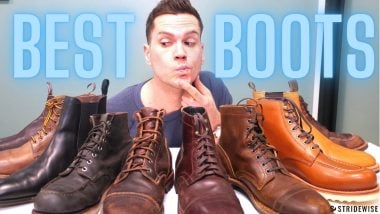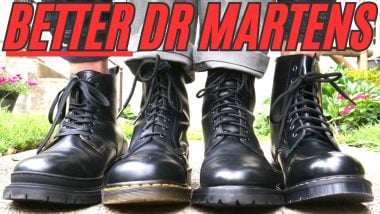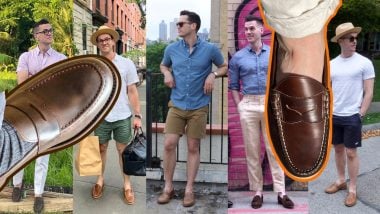“You have a blog about boots and jeans? And you make a living from that?”
My Dad asks me this exact question every time I see him — he always forgets the answer because he doesn’t understand the internet. You’re not the first person to wonder how we make money from a goofy blog, and we’re happy to explain how.
Our founding editor started Stridewise in 2018 while he was working at a startup fitness website ,where he was able to see a site get built from the ground up into a profitable business.
We started out just focusing on casual
There’s an element of “vintage” there, sure. But mostly, Nick wrote about stuff as he explored the kind of menswear he always wanted to find more of: no obnoxious branding, no superfluous features, just casual stuff that lasts a long time. (He likes the term “fashion proof” and half wishes that’s what he’d called the site.)
Anyway, we’re getting sidetracked. How does Stridewise sustain its operations and stay in the black?
A Diverse Revenue Model
Good business typically have a range of revenue streams, since this helps stabilize our accounts and make us a bit more resistant to seismic shifts in online media. (Yes, the various algorithms we rely on for traffic are always changing. It’s stressful!)
So we have several revenue streams that aren’t incredible moneymakers on their own, but they come together to generate enough revenue to keep the lights on and employ a diverse stable of writers and videographers.
You might have found us on YouTube, which makes us some money through the pre-roll ads, but the vast majority of the revenue comes from this website you’re graciously visiting. The site generates revenue primarily through affiliate commissions, on-site advertisements, and pixel sharing. We make a little money through cooler, more visible projects like sponsored content and product collaborations with brands.
Here’s what all that means.
Affiliate Commissions
You know how there are door-to-door salesmen who make a commission whenever they manage to sell their set of knives or whatever? That’s what affiliate marketing is. (This is how I explained it to my Dad, a former door-to-door salesman.)
To help generate online sales, a lot of online brands do affiliate marketing: if I link a product on the website or in a YouTube description, the URL I use will have a code in it that lets the brand know that I sent you to their site. If you buy something, I get a commission — usually around 5 or 10 percent. This does not increase the price of the product for you.
A few things to make really clear: we’re always happy to trash a company. Many brands have reached out to us to ask us to review their product, include a generous affiliate program, and then we’ll call it the worst piece of crap we’ve ever worn. We don’t let affiliate commissions dictate editorial strategy.
Also, a lot of brands we like — such as Frank Clegg and his briefcases — don’t take part in affiliate marketing or give us any commissions. We still cover them because we think they’re worth talking about. A lot of blogs like this will only ever talk about a brand if they pay commissions, but we think that’s a bit sleazy and it’s a disservice to our readers. You want to know about all of the good brands, not just the ones with a digital marketing budget.
More than once, we’ve put a company at the top of a “best whatever” list when they don’t even have an affiliate program. Like the time we said Rancourt’s Freeman boot is the best winter boot. We could have made money if we’d picked an affiliate for that spot! That video got a ton of views. If we were more business minded we’d never promote a brand without an affiliate program, but the fact is we’ve worked in online media for years and have grown to hate scammy online publishers as much as anyone. We only endorse a product if we really like it. (And if we’ve worn the hell out of them too.)
Another thing to note is that if a brand uses an affiliate link, it doesn’t increase the amount you pay. It comes out of the brand’s marketing budget. You don’t pay any more for a product whether or not you buy it through our link. It just helps you support our coverage.
Also, if someone is unhappy with a product and returns it, Stridewise earns no commission. So our financial goals are actually aligned with the readers’ goal of finding something they like and won’t return. If we suggest something you hate and you return it, we don’t make money, so why would we want to scam you into getting something not great?
Affiliate marketing incentivizes the creation of helpful, engaging content that readers trust, saving them time and aiding purchase decision making. If it didn’t exist, we wouldn’t be able to test gear full time for you and we couldn’t afford to post some of our reviews because we wouldn’t make back the money we spent getting the review written and filmed and photographed and edited. So, it’s handy. We honestly should use it more. But we use it a lot less than other brands in the space.
On-Site and YouTube Advertising
Another revenue source is good old fashioned advertisements, except they’re not that old fashioned because they’re on the internet.
On-Site Ads
Like I explain to my dad: you know how magazines have ads next to their articles to help pay for the magazine’s production? That’s like how Stridewise makes ad money. Think of us as an online magazine: you read articles you like and you might get interested in a product that advertises in a banner next to the words. Maybe!
This is more information than most blogs like this would reveal, but we use an ad network called Mediavine, which optimizes ad placements for maximum clickability without detracting from the user experience. Some ad networks just throw anything with a high commission in their ads, but Mediavine does a better job of showing you ads for stuff based on your browsing history, which means you’re more likely to actually want the product being advertised at you.
To be honest, we really like this kind of advertising. You know how when you watch TV you’ll get a ton of commercials you don’t need for, like, catheters and pet insurance? We vastly prefer online media’s alternative: I open Instagram, the app knows I’ve been been shopping for protein bars, and it suggests a brand that actually looks good. I buy a ton of stuff this way. It’s way better than old fashioned ads.
YouTube Ads
An active YouTube community supplements the ad network, with Stridewise’s YouTube channel boasting over 100K subscribers. YouTube ads tend to be less targeted than the ads on the site you’re reading now, the ads don’t pay much money anyway. Most people think of us as YouTubers first, but it’s extremely rare for a video’s ad revenue to pay for its production. (Like, it costs a few hundred bucks just to get a video edited, let alone filmed.)
Even though YouTube ads might be annoying, get this: we don’t put ads in the middle of videos. YouTube gives us the option to, and we tick “no,” because videos getting interrupted by ads is annoying. Again, this is bad business! We should be maximizing revenue every way we can! But, you know. Lots of ads are annoying, be the change you want to see in the world, and all that.
We know that you rarely want to see an ad, but content costs money to produce. We have more staff than you might think, and running a site and YouTube channel is way more work and much more of a business than you might imagine. (It’s certainly more of a real business than my Dad might think.) Like, we have multiple tech guys who have to keep the site from crashing, that kind of thing.
But we like to think we’ve hit a decent balance with the advertising.
Pixel Sharing
This is another way of helping you get ads for things you’re likely to actually find useful. Here’s how it works: if you come to Stridewise from a Google search about boots, there’s a good chance you’re interested in buying a pair of boots.
After you leave the site, a boot brand might show up in your Instagram or Facebook feed even though you weren’t searching for that particular brand. Let’s say you were Googling “Grant Stone boot review” and you wind up here. The next time you go to Instagram, you might get an ad for Red Wing boots, since those two brands have a lot of overlap in their customer base and Red Wing might be able to coax this boot shopper away from Grant Stone and over to their checkout page instead.
Those aren’t the brands that have pixels on the site (or are they?) but that’s another way we make revenue: being able to advertise at people who visit this site can be more valuable to a brand than advertising on a network like Mediavine, because people who visit this site are likely to fit the demographic of guy who is actively looking to spend $300 on new boots.
So that’s how pixels work. It’s basically the same way a brand you’ve previously searched might show up in the banner ads on stridewise.us, except it’s a brand following you from this site to another one.
Newsletter
Stridewise also publishes a weekly newsletter you will totally love that announces new content and sometimes highlights or promotes goings-on in the boot and menswear space, and sometimes a company might sling us a few bucks to include them.
Sponsored Content
Sometimes a company will give us some money to talk about them in a video or article. We don’t do this very much and we make sure it’s not something that has obvious ethical conflicts, like a Chelsea boot company sponsoring a review or a “best Chelsea boots” article.
An example is our list of the best selvedge denim brands. The video and article were sponsored by a wristwatch company we really like that has been called “the watch equivalent of Japanese raw denim.” It was an easy fit and didn’t (couldn’t) bring about bias in the article.
Collaborations
We’ve only done a couple of these: we help design a product and get our name closely associated with it. A good example is the wild boar leather boot that Caswell sold. When Caswell sold that boot, we got a higher commission than we would have if we had just used an affiliate link because we co-created the product itself and the brand we built was used to sell it.
Building a Brand
More than just a source of income, Stridewise represents a successful model of turning a personal passion into a thriving online business.
Our team’s background in journalism, search engine optimization, and content strategy — combined with our genuine interest in boots and menswear — has allowed Stridewise to rank highly for competitive keywords and become a trusted authority in the space.
The site’s expansion into related areas of durable, sustainable menswear, coupled with a growing content library of over 500 articles, demonstrates a commitment to quality and community beyond just profit.
Regular content updates, video production, and innovative marketing strategies like factory visits for exclusive brand stories underscore Stridewise’s unique position in the digital landscape.
All that is also just more work than most small websites like this put into their business — so, yeah, we need revenue.
Looking Forward
As Stridewise grows, its revenue streams provide a stable foundation for exploring new content, products, and services. Through affiliate marketing, advertising, and tried-and-true digital strategies, Stridewise is a solid model for turning a niche interest into a sustainable online platform that can hire good writers and make good content.





